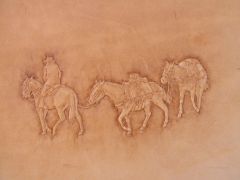-
Posts
272 -
Joined
-
Last visited
troy's Achievements

Member (2/4)
-
can't think of any body more dedicated to the art, as passionate about sharing it and as damn determined to push that summit just a little higher in order to ascend it then you Brian. So ya why not, they were nobodies at one time and you been a somebody for years already...so your really half way there. go get it man and no regrets.... Paul
-
Not sure if anybody's interested but these are some recent whip handles I've turned showing the raw inners - first and second layers of braiding are braided onto the steel/copper pin which are cut to make them flush/flat with the wooden handle, inserted back in and the last layer is glued on and sinewed over the narrow wooden end bit. once braided on and rolled the end knot and its foundation are glued, sinewed over this narrow piece. as with shown below, the wood is totally exposed, the knot is positioned directly over the narrow non sanded bit. from left to right - indian rosewood (medium weight wood, easy to carve) Black walnut (american black oak, quite a light wood, easy to carve but does'nt have the unique changes in rings as I like, quite a dull colour), Bubingo (semi dense wood of medium weight, colours or rings are quite unique, smells nice), Cocobolo ( one of the darker african woods like wenge, ebony, blackwood and thus like them is a hard heavy wood, harder to carve and blunts knives quicker but has interesting colors, textures, like this wood). Wood in cat shown below is thuya burr which unlike some burrs is dense enough for handles, carves like cheese, smells good also - will show an image of most favourite wood to turn (and also the most rare and expensive, its very heavey, very dense and very pretty - cost £80.00 for this piece; snakewood) I failed to mention that when the pin is inserted back into the wood (2 .5 inches in, 2.5 inches left showing, 6mm width - using 6mm bit) I drill a small hole throught the narrow wooden piece and pin (say a 2 or 3mm metal bit) and then insert a nail - although the pin fixes in really tight, this nail helps keep it all together for all those indy fans who like swinging - from a tree that is, not the other sort of swinging!
-
Not sure if this will help or not, but made a pdf of braiding a dog coller - flat, round to flat braid - a few years ago - http://www.mtn-m.co.uk/web%20components/whips/dog%20collar.pdf
-
its called micro paracord of about 2mm width, five star do it. and cheers for the comment, you must of dug deep to find this thread.
-

First Pan - Not As Planned But What Do You Thiunk?
troy replied to troy's topic in Motorcycles and Biker Gear
cheers for the comments leatheroo. I have now patched up the hole, so to speak although it looks atad like a false tooth amongst healthy one's. It was neopene that I used but I made the mistake of cutting to much and then having to sand to get rid of the ridges etc, that would have been seen/felt through the thin roo hide - what i should of done is perhaps just taped the padding on, done the cutting and then turned it but there you go hind sight is a great thing..... cheers again Paul -

First Pan - Not As Planned But What Do You Thiunk?
troy posted a topic in Motorcycles and Biker Gear
Originally I was gonna do a fancy carving job on this but decided to go with a whole roo hide seat instead using the flesh side of a tan colored hide for the seat as it has a nice pattern........used simple braids for the bottom bit as well as I did'nt have any rivots. The braid around the edge is a simple round braid. Is it just me or does the padding look to thin - I did start with a pad 1 inch thick, then sanded it......... Cheers Paul -
swop all the leather as listed/shown below (not seperatly) for two pieces of veg tanned carving leather. both of dimensions 30 x 40cms or roughly to dimensions shown in first photo below, one of 4mm upto whatever thickness, the other about 2 or 3mm. Would be handy if the thicker piece has no marks. will need photo of them first and they are for a chopper pan seat project. supple kip leather measuring 45 x 20 inches (an average width measuremnt taken half way along it) by 2mm thick at the long end to 1.5mm at the narrow end. Has some holes and a branding mark that looks like the word MAP. tan color, would be good for reinactment etc... Veg tanned Kangaroo off cuts of various of 1.5mm thickness in black, tan, and brown Sheepskin clothing nappa of 0.6 - 0.75mm thick in red and navy blue. navy blue is an whole hide of about 2.5 x 2.5ft and the red is slightly smaller but has pen marks on it. please email me at Paul@mtn-m.co.uk with offers/questions...normally I say that we both pay postage for the leather we send. Cheers Paul
-
cheers for the idea Brian, have looked into it a bit but I think I'll stick with the roo braiding as I know how to do that and this project is'nt really the sort to try out new things, but ye does look good... Cheers Paul
-
see photo below, it is of a plan for a chopper seat with a high curved back. As can be seen, I plan to do a largish expanse of flat braiding where basically the seat won't be sat on, rather rested against. Evenso with this expance of braiding I forsee the braided rising off of the leather due to the curve. To remedy this I have decided to not braid the letters but rather braid around them using the seat leather as the letters, if you get my meaning thus pressing the braid against the leather. I would of rathered braidied the letters as normal but could'nt think of a way to ensure the braid stays against the leather - any body done something similar and got a better idea? Cheers Paul
-

Ok Got The Seat, What Should I Use To Weatherproof It?
troy replied to troy's topic in Motorcycles and Biker Gear
Feels like years since starting the upgrade of my bike, but now the new seats are on, new paint job done, just gotta polish all my greasy finder marks off of the chrome....Sooo what do you think, do the seats suit this bike or not, I'm in two minds at the moment but I'm sure a summer of crusing will solve that . -
In my humble opinion, Ron's volume 2 is about the round braids is the bee's knee's;. I make loads of knots, have do for years of all P's and B's - if it ain't in the book (which is very unlikely), it gives you enough to figure out others yourself. If like me and you haven't grown out of the beano then your find the pictures easy peasy to follow, but the full U's and O's for each knot are their as well for the grown up's. His whip making book is also a dandy of a read for long braids and such, fid work etc etc braiding letters, plus his leather lacing book is great for edge braids. - all good books that have in the 4 plus years I've had them, have never needed dusting - and I shed like a snake.......
-
-
thanks for the comments. When you say double bevel, I'm presuming if memory serves that that means bevel the hoof and the ground where they meet?
-
Been awhile since I've carved a horse as part of a landscape and can't for the life of me remember if to imitate its hooves being on the ground you should either bevel the ground beaneth it or of the hoof where it meets the ground. cheers Paul
-
Finally after years waiting, it seems their is a horse rawhide supplier. Correct me if I'm wrong but I have thought that horse rawhide is better ( as in just as thin but denser then deer rawhide) for fine braiding or any braiding, then deer rawhide. This is the supplier - http://www.barrheadleather.co.uk/raw-hide-c46.html - I have used their seconds hides and found them to be great for braiding, yet to try out the horse which will depend if fellow braiders here know if horse is indeed better then deer, i.e won't stretch as much when damp and is still thin enough for narrow strings. cheers Paul

















